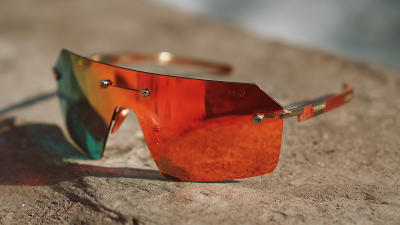The global market for Smart Sunglasses is rapidly evolving, driven by advancements in augmented reality (AR) and the increasing demand for wearable technology. According to a report by Grand View Research, the smart eyewear market is projected to reach approximately $70 billion by 2026, with a compound annual growth rate (CAGR) of 25.2% from 2019 to 2026. This surge indicates a growing consumer interest in integrating technology with everyday accessories, enhancing both functionality and style. As brands strive to capture a share of this lucrative market, implementing top strategies for maximizing sales of Smart Sunglasses becomes essential. From leveraging social media influencers to optimizing user experience through advanced features, understanding and addressing consumer needs will be pivotal in this competitive landscape.

Smart sunglasses have come to the forefront of wearable technology, offering features that distinctly set them apart from traditional eyewear. One of the primary differentiators is the integration of augmented reality (AR) capabilities, enabling users to experience an enhanced visual reality. According to a report by Mordor Intelligence, the global smart glasses market is expected to witness a compound annual growth rate (CAGR) of 55.3% from 2021 to 2026, indicating a rapid adoption of AR and related technology. This surge highlights the growing demand for products that merge functionality with everyday technology.
Another key feature that elevates smart sunglasses above their conventional counterparts is the inclusion of advanced connectivity options. Smart sunglasses often come equipped with Bluetooth and voice control functionalities, allowing seamless integration with smartphones and smart devices. A study from Research and Markets estimates that the connected eyewear segment will reach a value of $16.5 billion by 2024, further emphasizing the importance of connectivity in driving consumer interest. These features not only appeal to tech-savvy users but also cater to those seeking convenience and innovativeness in their daily accessories. As companies continue to innovate, the distinction between smart sunglasses and traditional options will become increasingly pronounced, paving the way for broader market penetration.
The global market for smart sunglasses is rapidly evolving, influenced by diverse consumer preferences across various regions. In North America, for instance, there is a strong demand for advanced technology integrated within eyewear, such as augmented reality and connectivity features. Consumers in this region prioritize functionality and innovation, seeking products that enhance their lifestyle through seamless integration with other digital devices.
Conversely, in Europe, consumers place a higher value on style and brand reputation when considering smart sunglasses. The emphasis on aesthetic appeal and luxury branding shapes purchasing decisions, indicating that manufacturers must focus on design elements while maintaining technological advancements. Moreover, in regions such as Asia-Pacific, affordability and durability take precedence, as consumers are increasingly drawn to smart sunglasses that offer good value without compromising on advanced features. This regional differentiation in consumer preferences highlights the need for tailored marketing strategies that resonate with specific cultural values and expectations in order to effectively maximize sales worldwide.
| Region | Consumer Preference (%) | Key Features Desired | Purchase Intent (%) | Average Price Willing to Pay ($) |
|---|---|---|---|---|
| North America | 65 | AR capabilities, UV protection, Bluetooth | 70 | 200 |
| Europe | 58 | Fashionable design, battery life, audio quality | 65 | 180 |
| Asia | 75 | Integration with smartphones, fashion appeal, customization options | 80 | 150 |
| South America | 42 | Affordability, UV protection, light weight | 50 | 100 |
| Africa | 37 | Durability, UV protection, local designs | 40 | 75 |
In the competitive landscape of smart sunglasses, pricing strategies play a crucial role in maximizing sales. A comprehensive competitive analysis reveals that consumer perceptions around price can greatly influence purchasing decisions. Brands need to consider not only the direct costs of materials and technology but also how to position themselves against rivals. Some companies have opted for a pricing strategy aimed at educating the market, even if it requires initial losses. This approach can build long-term brand loyalty and foster market growth as consumers become familiar with the benefits of smart eyewear.
Moreover, understanding the broader market trends is essential. As the eyewear industry evolves, examining upcoming opportunities, such as advancements in technology and functionality, allows brands to innovate their product offerings effectively. For instance, with the increasing popularity of sports eyewear that blends performance with smart technology, companies can leverage differentiated pricing strategies to tap into niche markets. By focusing on both competitive analysis and targeted pricing, brands can enhance their market position and boost sales in the rapidly growing segment of smart sunglasses.
To effectively promote smart sunglasses, leveraging the right marketing channels is crucial. Social media platforms such as Instagram and TikTok are prime for showcasing innovative eyewear. The visual-centric nature of these platforms allows brands to create engaging content, including influencer collaborations and user-generated photos. Regularly posting stylish visuals and demonstrating the product's unique features through short videos can captivate potential customers, driving interest and desire.

Additionally, targeted email marketing campaigns can play a significant role in reaching consumers. By curating personalized content that matches the interests and behaviors of specific segments, brands can effectively inform potential buyers about new launches, special offers, and exclusive promotions. Combining this with informative blogs or articles about the technology behind smart sunglasses, including their health benefits and user guides, helps build credibility and establishes a stronger relationship with potential customers. Ultimately, effective use of these platforms can amplify brand visibility and foster customer engagement, leading to increased sales.
When it comes to maximizing the sales of smart sunglasses worldwide, user experience is paramount. The design and functionality of these devices can significantly influence consumer choices. In recent years, the market has seen remarkable growth, highlighted by a staggering 210% increase in shipments largely driven by user-friendly features and appealing aesthetics. To compete in this rapidly evolving market, brands must prioritize intuitive designs that enhance daily usability while incorporating advanced functionalities like real-time translation and music streaming.

Tip 1: Focus on Ergonomics - Ensure that smart sunglasses are comfortable to wear for extended periods. Lightweight materials and adjustable frames can greatly improve user satisfaction.
Tip 2: Invest in Aesthetic Appeal - The visual design should attract consumers who view these products not just as tech gadgets, but also as fashion accessories. Collaborating with fashion brands can bridge the gap between functionality and style.
Moreover, staying ahead of the curve in technology while offering seamless integration with other devices will also help in driving sales. By prioritizing user experience through thoughtful design and innovative features, brands can entice a wider audience and achieve greater market success.





